YAMAHA XL 700 2001 Owner's Manual
Manufacturer: YAMAHA, Model Year: 2001, Model line: XL 700, Model: YAMAHA XL 700 2001Pages: 111, PDF Size: 12.05 MB
Page 21 of 111
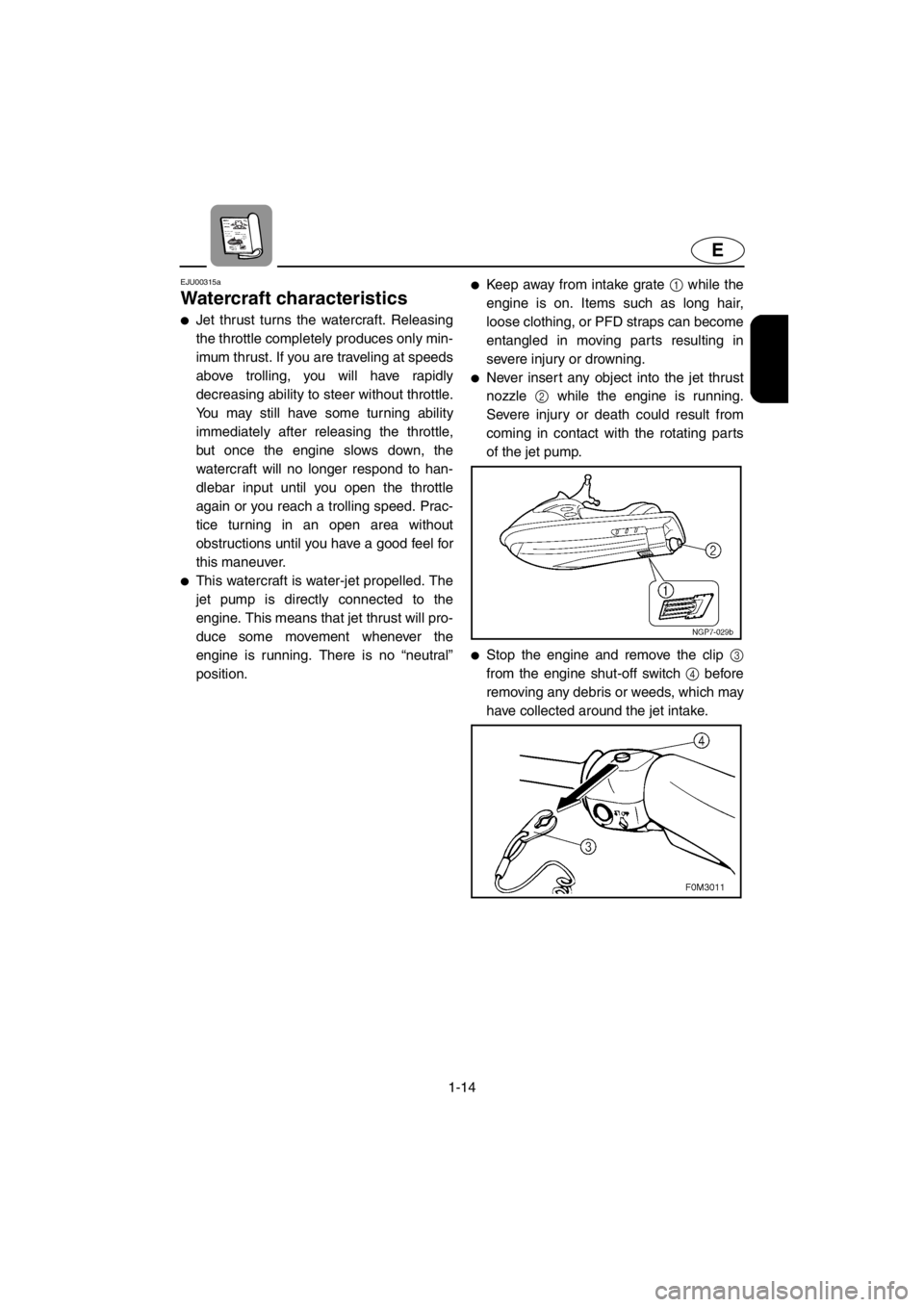
1-14
E
EJU00315a
Watercraft characteristics
●Jet thrust turns the watercraft. Releasing
the throttle completely produces only min-
imum thrust. If you are traveling at speeds
above trolling, you will have rapidly
decreasing ability to steer without throttle.
You may still have some turning ability
immediately after releasing the throttle,
but once the engine slows down, the
watercraft will no longer respond to han-
dlebar input until you open the throttle
again or you reach a trolling speed. Prac-
tice turning in an open area without
obstructions until you have a good feel for
this maneuver.
●This watercraft is water-jet propelled. The
jet pump is directly connected to the
engine. This means that jet thrust will pro-
duce some movement whenever the
engine is running. There is no “neutral”
position.
●Keep away from intake grate 1 while the
engine is on. Items such as long hair,
loose clothing, or PFD straps can become
entangled in moving parts resulting in
severe injury or drowning.
●Never insert any object into the jet thrust
nozzle 2 while the engine is running.
Severe injury or death could result from
coming in contact with the rotating parts
of the jet pump.
●Stop the engine and remove the clip 3
from the engine shut-off switch 4 before
removing any debris or weeds, which may
have collected around the jet intake.
E_F0M-72-1.fm Page 14 Thursday, July 27, 2000 10:40 AM
Page 22 of 111
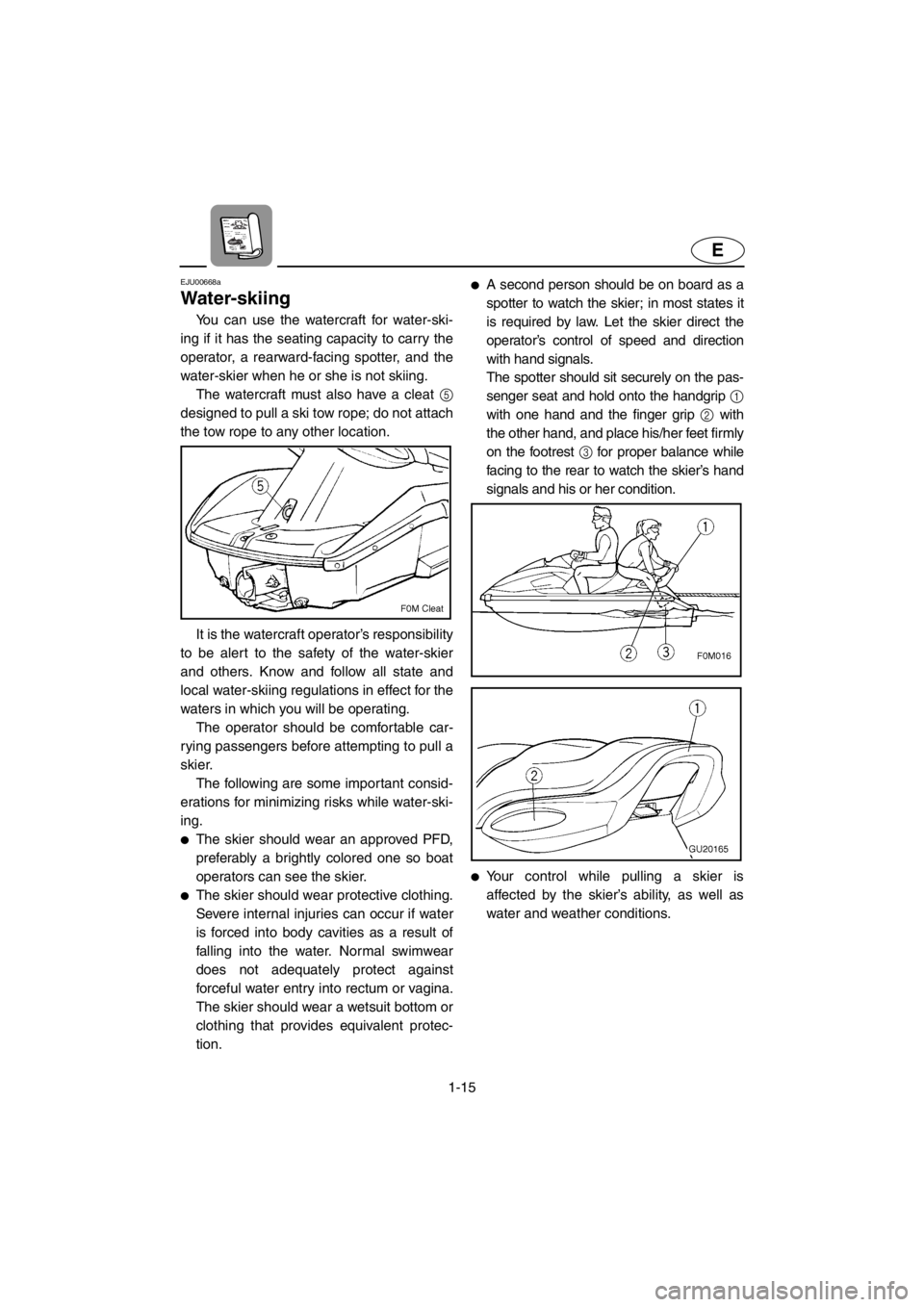
1-15
E
EJU00668a
Water-skiing
You can use the watercraft for water-ski-
ing if it has the seating capacity to carry the
operator, a rearward-facing spotter, and the
water-skier when he or she is not skiing.
The watercraft must also have a cleat 5
designed to pull a ski tow rope; do not attach
the tow rope to any other location.
It is the watercraft operator’s responsibility
to be alert to the safety of the water-skier
and others. Know and follow all state and
local water-skiing regulations in effect for the
waters in which you will be operating.
The operator should be comfortable car-
rying passengers before attempting to pull a
skier.
The following are some important consid-
erations for minimizing risks while water-ski-
ing.
●The skier should wear an approved PFD,
preferably a brightly colored one so boat
operators can see the skier.
●The skier should wear protective clothing.
Severe internal injuries can occur if water
is forced into body cavities as a result of
falling into the water. Normal swimwear
does not adequately protect against
forceful water entry into rectum or vagina.
The skier should wear a wetsuit bottom or
clothing that provides equivalent protec-
tion.
●A second person should be on board as a
spotter to watch the skier; in most states it
is required by law. Let the skier direct the
operator’s control of speed and direction
with hand signals.
The spotter should sit securely on the pas-
senger seat and hold onto the handgrip 1
with one hand and the finger grip 2 with
the other hand, and place his/her feet firmly
on the footrest 3 for proper balance while
facing to the rear to watch the skier’s hand
signals and his or her condition.
●Your control while pulling a skier is
affected by the skier’s ability, as well as
water and weather conditions.
E_F0M-72-1.fm Page 15 Thursday, July 27, 2000 10:40 AM
Page 23 of 111

1-16
E
●When preparing to pull a skier, operate
the watercraft at the slowest possible
speed until the watercraft is well away
from the skier and slack in the towrope is
taken up. Make sure that the rope is not
looped around anything.
After checking that the skier is ready and
that there is no traffic or other obstacles,
apply enough throttle to raise the skier.
●Make smooth, wide turns. The watercraft
is capable of very sharp turns, which
could exceed the abilities of the skier.
Keep the skier at least 50 m (150 ft),
about twice the distance of a standard
towrope, from any potential hazard.
●Be alert to the hazard of the towrope han-
dle snapping back at the watercraft when
the skier falls or is unable to get up on the
skis.
●Towing heavy or bulky objects other than
skiers, such as another boat or watercraft,
can cause loss of steering control and
create a hazardous condition. If you must
tow another boat in an emergency situa-
tion, operate slowly and cautiously.
EJU00319
Safe boating rules
Your Yamaha watercraft is legally consid-
ered a powerboat. Operation of the water-
craft must be in accordance with the rules
and regulations governing the waterway on
which it is used.
E_F0M-72-1.fm Page 16 Thursday, July 27, 2000 10:40 AM
Page 24 of 111

1-17
E
EJU00322
Enjoy your watercraft
responsibly
You share the areas you enjoy when
riding your watercraft with others and with
nature. So your enjoyment includes a
responsibility to treat these other people,
and the lands, waters, and wildlife with
respect and courtesy.
Whenever and wherever you ride, think of
yourself as the guest of those around you.
Remember, for example, that the sound of
your watercraft may be music to you, but it
could be just noise to others. And the excit-
ing splash of your wake can make waves
others won’t enjoy. Avoid riding close to
shoreline homes and waterfowl nesting
areas or other wildlife areas, and keep a
respectful distance from fishermen, other
boats, swimmers, and populated beaches.
When travel in areas like these is unavoid-
able, ride slowly and obey all laws.
Remember that pollution can be harmful
to the environment. Do not refuel or add oil
where a spill could cause damage to nature.
Remove your watercraft from the water and
move it away from the shoreline before refu-
eling. And keep your surroundings pleasant
for the people and wildlife that share the
waterways: don’t litter!
When you ride responsibly, with respect
and courtesy for others, you help ensure
that our waterways stay open for the enjoy-
ment of a variety of recreational opportuni-
ties.
E_F0M-72-1.fm Page 17 Thursday, July 27, 2000 10:40 AM
Page 25 of 111
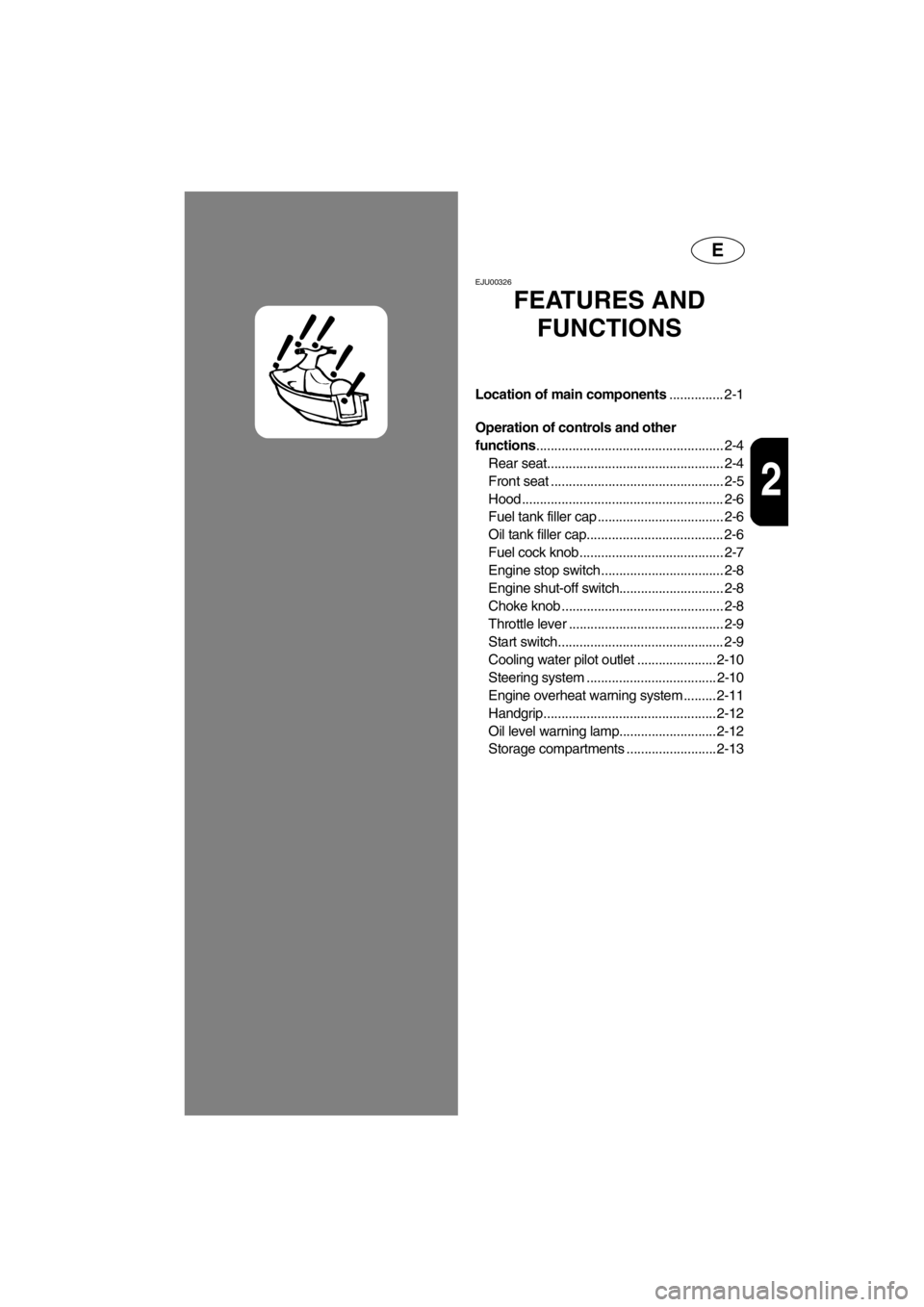
E
2
EJU00326
FEATURES AND
FUNCTIONS
Location of main components............... 2-1
Operation of controls and other
functions.................................................... 2-4
Rear seat................................................. 2-4
Front seat ................................................ 2-5
Hood ........................................................ 2-6
Fuel tank filler cap ................................... 2-6
Oil tank filler cap...................................... 2-6
Fuel cock knob........................................ 2-7
Engine stop switch .................................. 2-8
Engine shut-off switch............................. 2-8
Choke knob ............................................. 2-8
Throttle lever ........................................... 2-9
Start switch.............................................. 2-9
Cooling water pilot outlet ...................... 2-10
Steering system .................................... 2-10
Engine overheat warning system ......... 2-11
Handgrip................................................ 2-12
Oil level warning lamp........................... 2-12
Storage compartments ......................... 2-13
E_F0M-72-2TOC.fm Page 1 Thursday, July 27, 2000 9:50 AM
Page 26 of 111
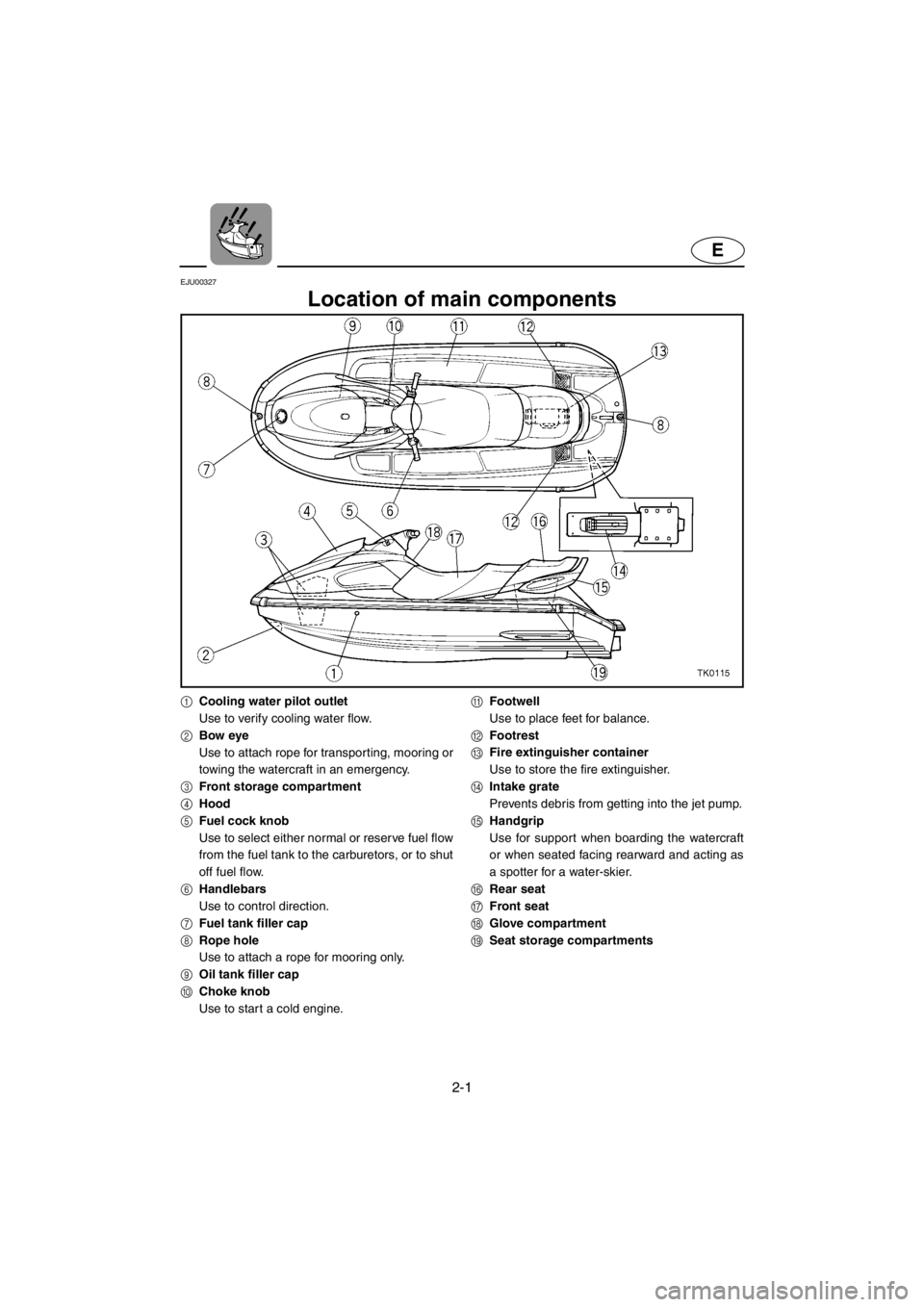
2-1
E
EJU00327
Location of main components
1Cooling water pilot outlet
Use to verify cooling water flow.
2Bow eye
Use to attach rope for transporting, mooring or
towing the watercraft in an emergency.
3Front storage compartment
4Hood
5Fuel cock knob
Use to select either normal or reserve fuel flow
from the fuel tank to the carburetors, or to shut
off fuel flow.
6Handlebars
Use to control direction.
7Fuel tank filler cap
8Rope hole
Use to attach a rope for mooring only.
9Oil tank filler cap
0Choke knob
Use to start a cold engine.AFootwell
Use to place feet for balance.
BFootrest
CFire extinguisher container
Use to store the fire extinguisher.
DIntake grate
Prevents debris from getting into the jet pump.
EHandgrip
Use for suppor t when boarding the watercraft
or when seated facing rearward and acting as
a spotter for a water-skier.
FRear seat
GFront seat
HGlove compartment
ISeat storage compartments
E_F0M-72-2.fm Page 1 Thursday, July 27, 2000 9:50 AM
Page 27 of 111
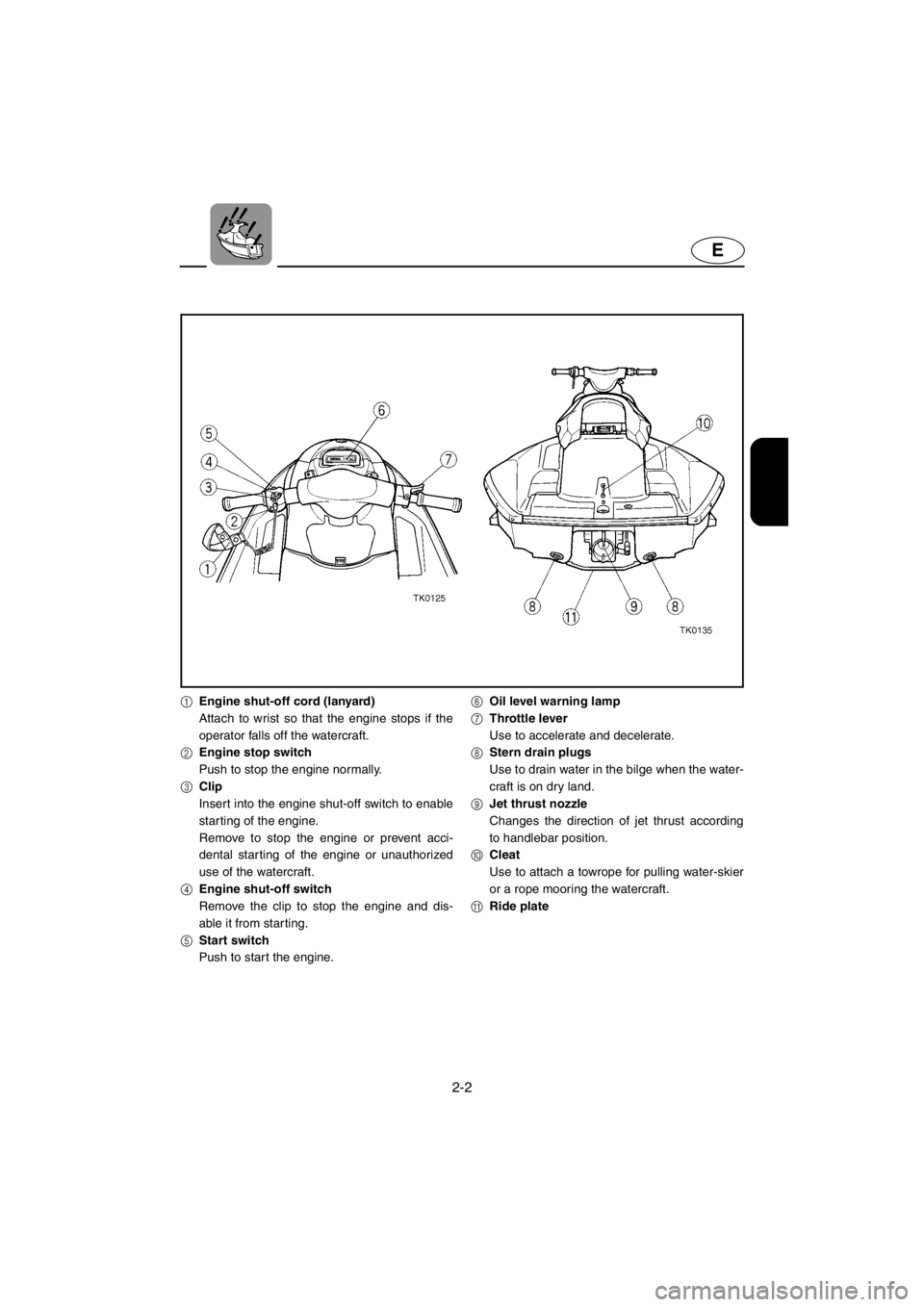
2-2
E
1Engine shut-off cord (lanyard)
Attach to wrist so that the engine stops if the
operator falls off the watercraft.
2Engine stop switch
Push to stop the engine normally.
3Clip
Insert into the engine shut-off switch to enable
starting of the engine.
Remove to stop the engine or prevent acci-
dental star ting of the engine or unauthorized
use of the watercraft.
4Engine shut-off switch
Remove the clip to stop the engine and dis-
able it from starting.
5Start switch
Push to start the engine.6Oil level warning lamp
7Throttle lever
Use to accelerate and decelerate.
8Stern drain plugs
Use to drain water in the bilge when the water-
craft is on dry land.
9Jet thrust nozzle
Changes the direction of jet thrust according
to handlebar position.
0Cleat
Use to attach a towrope for pulling water-skier
or a rope mooring the watercraft.
ARide plate
E_F0M-72-2.fm Page 2 Thursday, July 27, 2000 9:50 AM
Page 28 of 111
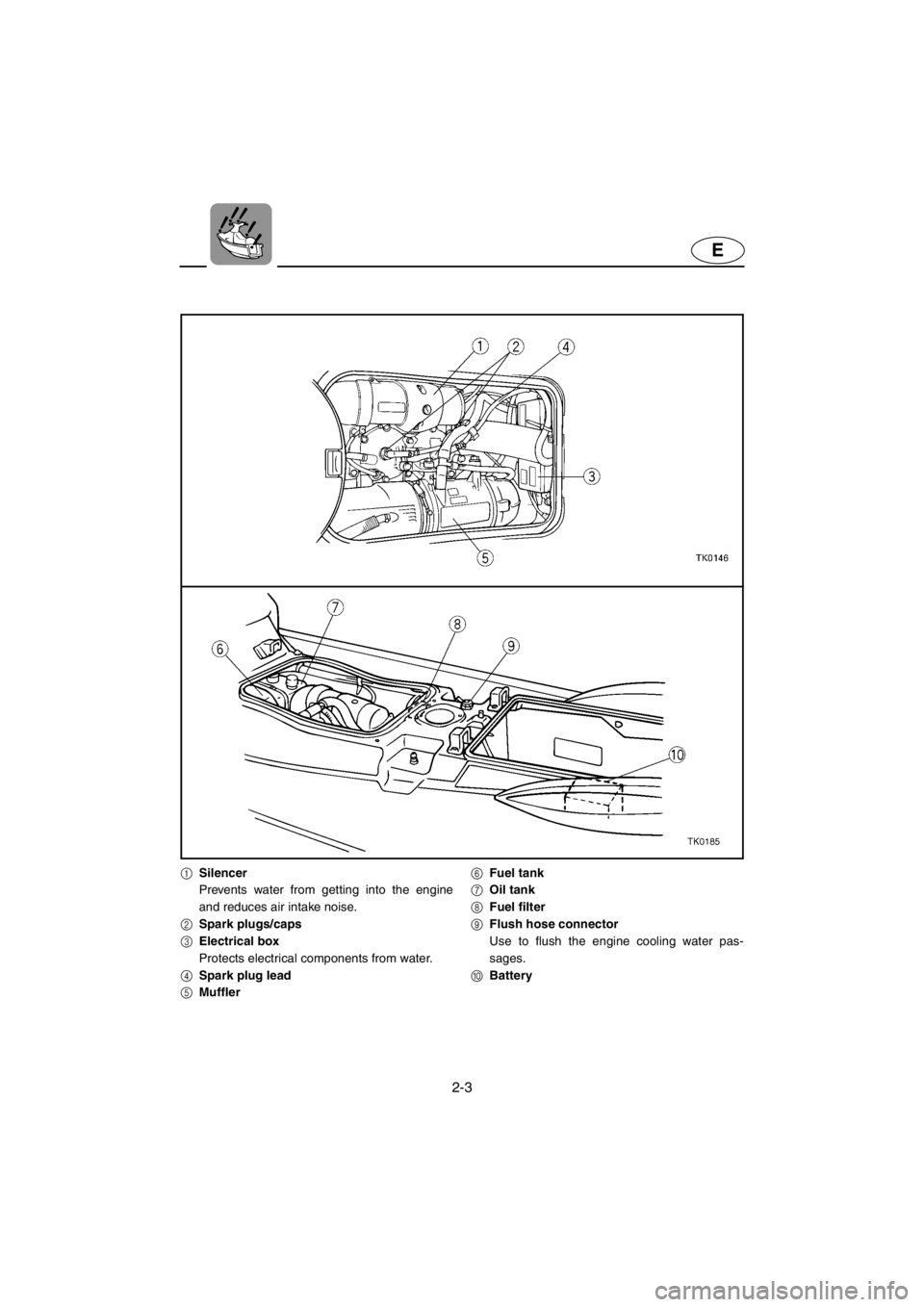
2-3
E
1Silencer
Prevents water from getting into the engine
and reduces air intake noise.
2Spark plugs/caps
3Electrical box
Protects electrical components from water.
4Spark plug lead
5Muffler6Fuel tank
7Oil tank
8Fuel filter
9Flush hose connector
Use to flush the engine cooling water pas-
sages.
0Battery
E_F0M-72-2.fm Page 3 Thursday, July 27, 2000 9:50 AM
Page 29 of 111
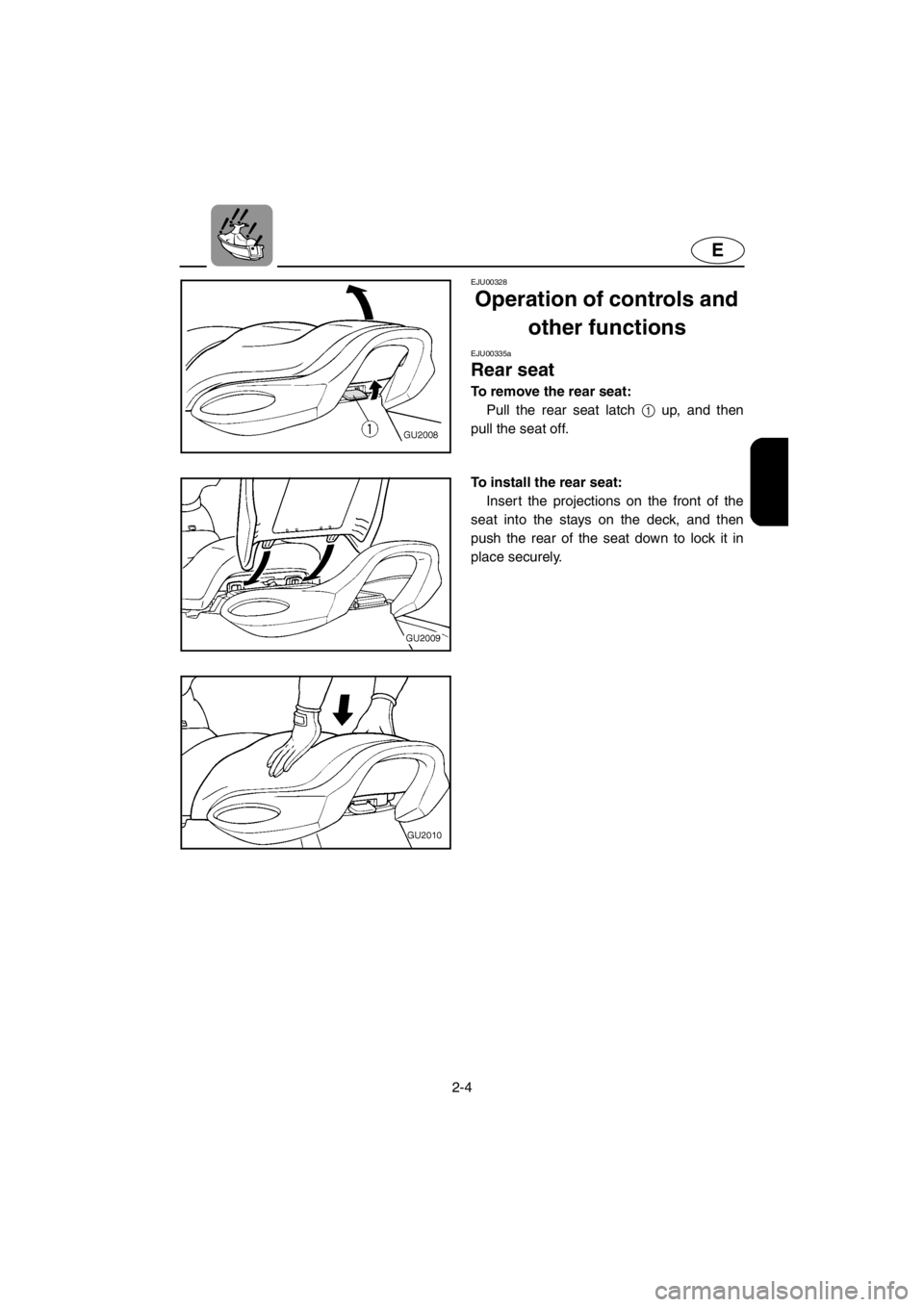
2-4
E
EJU00328
Operation of controls and
other functions
EJU00335a
Rear seat
To remove the rear seat:
Pull the rear seat latch 1 up, and then
pull the seat off.
To install the rear seat:
Insert the projections on the front of the
seat into the stays on the deck, and then
push the rear of the seat down to lock it in
place securely.
E_F0M-72-2.fm Page 4 Thursday, July 27, 2000 9:50 AM
Page 30 of 111
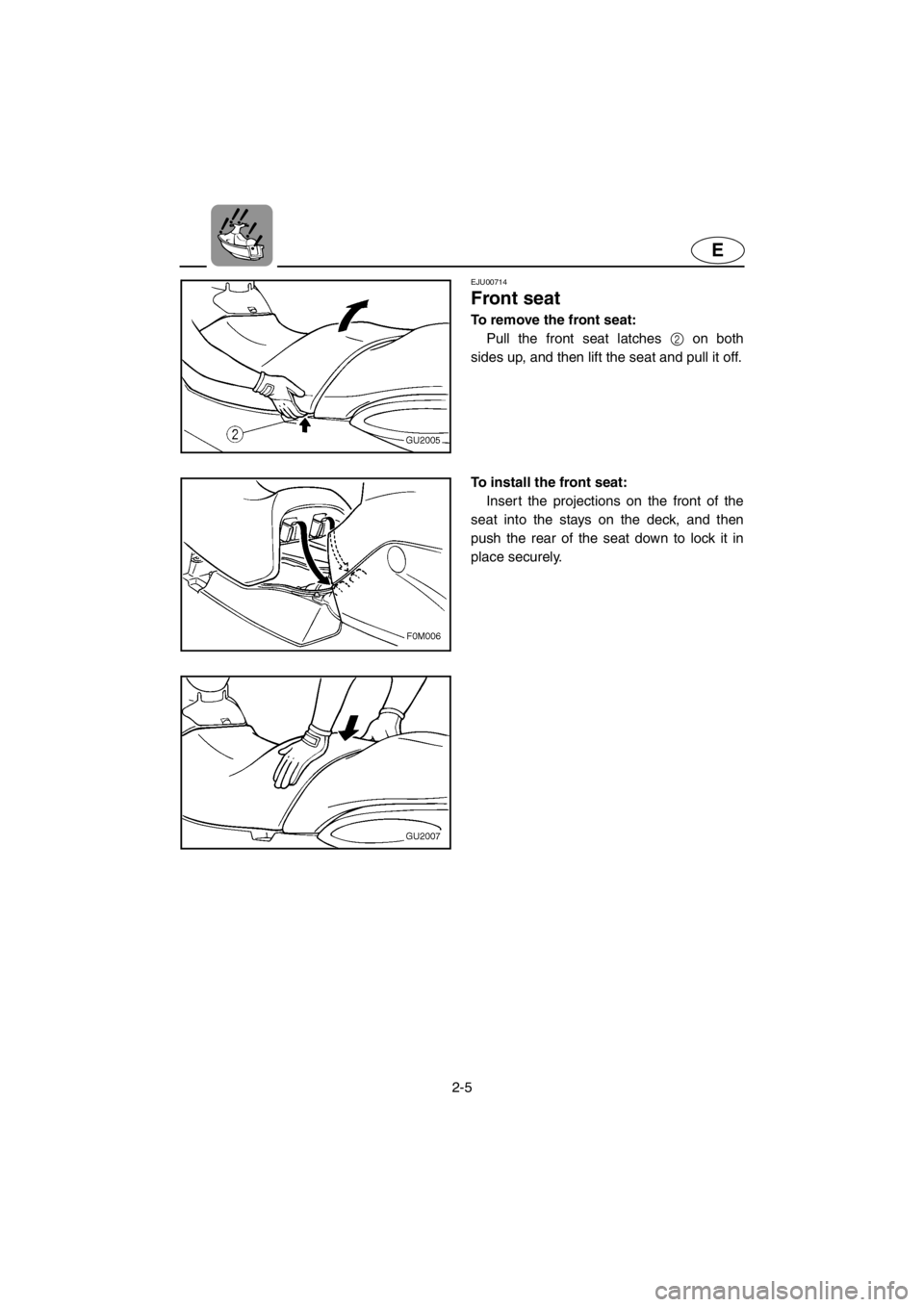
2-5
E
EJU00714
Front seat
To remove the front seat:
Pull the front seat latches 2 on both
sides up, and then lift the seat and pull it off.
To install the front seat:
Insert the projections on the front of the
seat into the stays on the deck, and then
push the rear of the seat down to lock it in
place securely.
E_F0M-72-2.fm Page 5 Thursday, July 27, 2000 9:50 AM